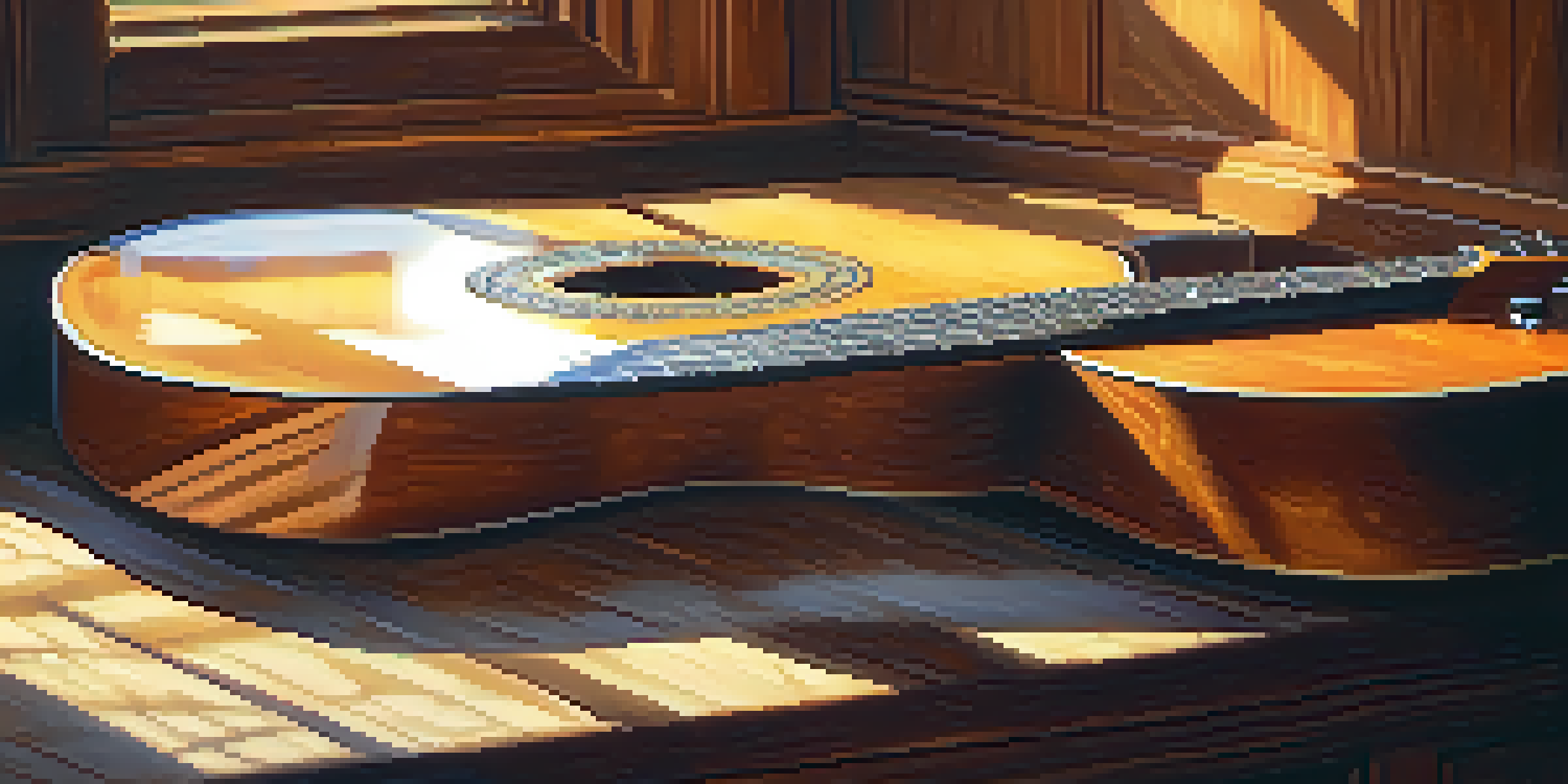The Importance of Dynamics in Guitar Music Composition

What Are Dynamics in Music Composition?
Dynamics in music refer to the varying degrees of loudness or softness in a piece. They are essential for conveying emotion and creating contrast within a composition. Understanding dynamics helps musicians express feelings more vividly, making the music more engaging for listeners.
Music is the shorthand of emotion.
In guitar music specifically, dynamics can transform a simple melody into a powerful narrative. For instance, playing softly can evoke tenderness, while strumming loudly can convey excitement or urgency. This interplay of volume adds depth to the performance.
Ultimately, dynamics serve as a musical language, allowing composers to communicate their intentions and connect with the audience on a deeper level. Without them, music would lack the emotional pull that keeps listeners captivated.
The Role of Dynamics in Emotional Expression
Dynamics play a crucial role in conveying emotions in guitar music. For example, a soft, gentle passage might evoke feelings of nostalgia, while a sudden loud section can create tension or surprise. This dynamic contrast draws the listener's attention and enhances the storytelling aspect of the music.

Consider a love song where the guitarist employs soft dynamics during the verses to reflect vulnerability and intimacy. When the chorus hits, they might increase the volume to emphasize passion and intensity. Such dynamic shifts can make the listening experience more immersive and relatable.
Dynamics Enhance Emotional Expression
Dynamics in music play a crucial role in conveying emotions, allowing performers to evoke feelings and create tension through variations in volume.
By thoughtfully incorporating dynamics, composers can guide the emotional journey of their audience. It’s like painting a picture with sound, where each brushstroke—each dynamic marking—adds to the overall mood and message.
Creating Contrast Through Dynamics
One of the most effective ways to keep listeners engaged is by creating contrast through dynamics. By alternating between soft and loud sections, composers can maintain interest and highlight key moments in their music. This technique often leads to a more memorable experience.
The dynamics of music are the language of the heart.
For instance, think about a guitar solo that begins quietly, allowing the listener to focus on intricate fingerwork. Suddenly, the volume swells, unleashing a torrent of sound that captures attention. This dynamic contrast not only surprises the audience but also enhances the emotional impact of the music.
In essence, dynamics serve as a tool for composers to craft a compelling narrative. Just like a good story needs high and low points, a piece of music benefits from the ebb and flow created by varying dynamics.
Dynamics and Musical Styles
Different musical styles utilize dynamics in unique ways, which can greatly affect the overall feel of the piece. In classical guitar music, for example, composers often indicate precise dynamic markings to guide the performer. This attention to detail allows for a rich, expressive interpretation of the work.
On the other hand, in rock or pop genres, dynamics might be used more liberally, allowing guitarists to experiment with volume to create excitement. A power chord played at full volume can energize a crowd, while a quiet, reflective passage can provide a moment of introspection.
Contrast Keeps Listeners Engaged
Creating contrast through dynamic shifts between soft and loud sections helps maintain listener interest and highlights key moments in a composition.
Understanding how dynamics function within various genres can help guitarists make more informed choices in their compositions. By embracing the dynamic characteristics of their style, they can better connect with their audience and enhance the musical experience.
The Influence of Dynamics on Performance
Dynamics greatly influence how a piece is performed, affecting both the guitarist's technique and the overall interpretation of the music. A skilled guitarist must be aware of the dynamic markings and adjust their playing style accordingly. This includes varying their picking intensity, finger placement, and even the type of guitar used.
For example, a softer dynamic might require lighter fingerpicking, while louder sections may call for aggressive strumming. These subtle changes not only enhance the sound but also allow the guitarist to communicate the emotional undercurrents of the piece effectively.
Ultimately, the way dynamics are executed can make or break a performance. A passionate interpretation with well-managed dynamics can leave a lasting impression, whereas a lackluster approach may fail to resonate with the audience.
Dynamics in Composing Original Guitar Music
When composing original guitar music, incorporating dynamic variations is essential for creating a compelling piece. It allows composers to explore the full range of emotions and narrative arcs within their music. By thoughtfully integrating dynamics, they can elevate their compositions from simple melodies to complex, engaging works.
For instance, starting a piece with a soft, haunting melody can set a reflective mood, while building to a powerful climax with dynamic swells can provide a sense of resolution. These contrasts not only enhance the composition but also guide the listener through an emotional journey.
Mastering Dynamics Requires Practice
To effectively incorporate dynamics in guitar playing, musicians must practice various techniques and explore different volumes to gain greater control.
Moreover, experimenting with dynamics can lead to innovative sounds and ideas. Composers are encouraged to push their creative boundaries, allowing dynamics to shape the identity of their music and make it truly their own.
Tips for Mastering Dynamics on Guitar
Mastering dynamics on the guitar requires practice and intentionality. One effective tip is to experiment with different picking techniques, such as fingerstyle or using a pick, to discover how each affects the volume and tone. This exploration can help guitarists gain greater control over their dynamics.
Additionally, practicing scales and chords at varying volumes can enhance dynamic awareness. Try playing a scale softly and gradually increasing the volume, then doing the reverse. This exercise will help develop an intuitive understanding of how to manipulate dynamics during performances.

Finally, listening to a diverse range of guitarists can provide inspiration and insight into dynamic execution. Pay attention to how different artists use dynamics to enhance their music and consider how those techniques can be integrated into your own playing style.